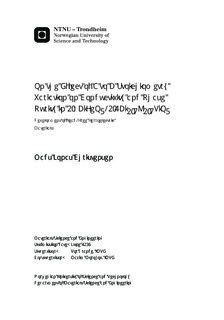| dc.description.abstract | Piezoelectric materials are currently widely used in both electronics and transducer applications. Today, the majority of these units are based on the lead containing material system PZT, and release of lead to the environment during synthesis or through waste is a challenge. Lately, much research has been done into alternative lead-free materials. One of the promising alternatives is bismuth ferrite, BiFeO3 (BFO), which shows high polarization, Curie temperature and strain response, as well as being multiferroic at room temperature. However, the properties are not easily utilized due to high conductivity, yielding leakage currents when external fields in the order of the coercive field are applied.The too high conductivity appear to originate form p-type conduction, with localized holes, or polarons, on the iron sub lattice. Iron is able to contain several valence states, where Fe^(3+) is default in BFO. Oxidation to Fe^(4+) corresponds to a hole on the iron site, yielding p-type conduction, while reduction to Fe^(2+) corresponds to an electron, yielding n-type conduction. The origin of the intrinsic concentration of holes is argued to be evaporation of bismuth oxide during synthesis, causing bismuth and oxygen vacancies. Oxygen vacancies will then create an equilibrium with holes, in accordance with 2Fe^(3+)+0.5O2(g)->2Fe^(4+)+O^(2-). Le Chatelier's principle then states that an increase of oxygen vacancy concentration should also cause an increase in concentration of holes, yielding an increase in conductivity.Synthesis of phase pure samples of BFO has also proven to be a challenge. Sillenite and mullite are commonly observed parasitic secondary phases, and bismuth potassium titanate is here solved in BFO in order to avoid these phases. Potassium and titanium stabilize the perovskittic phase, and synthesis of 0.8BFO-0.2BKT (BKTF-80) does not show the same parasitic decomposition. The promising features of BFO are not strongly affected by this composition change, however.It is here investigated which effect variation of A to B stoichiometry has on conductivity and phase purity of BKTF-80. To do this, samples are prepared where A cation oxides are (1) added for 1 and 2 % A excess, and (2) removed for 1 and 3 % A deficiency, in addition to (3) the stoichiometric sample. This corresponds to (Bi0.9K0.1)1+x(Fe0.8Ti0.2)O3, where x=-0.03,-0.01,0,0.01,0.02.It is expected that this will cause B vacancies for A excess, and A vacancies for A deficiency, and that these in both cases are balanced by oxygen vacancies. That is, the concentration of oxygen vacancies will be lowest where A excess corresponds to evaporation, and increase with deviation in either direction. The conductivity is assumed to follow the same development.Obtained results show that the perovskite phase is not able to accommodate the variation of A to B stoichiometry, but rather secondary phases are formed. Consequently, the expected conductivity development is not observed. To the contrary, conductivity is shown to be lowest for A deficient samples, increasing as stoichiometry is varied toward A excess. This is argued to originate in part from titanium doping, when excess titanium is solved in the perovskite, as opposed to excess iron, which forms a secondary phase. However, the variation in conductivity is so large that other effects are suspected to also play a part.Further work primarily constitutes investigation of the influence of atmospheric history, as differences due to variations in reducing conditions may help identify the source of conduction. | nb_NO |

